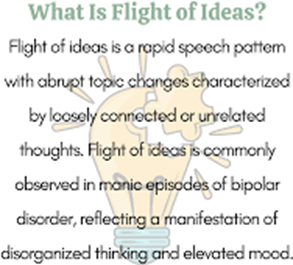During the mental status examination, the nurse observes that the client rapidly changes from one idea to another related thought. Which disordered thinking process is the client displaying?
Ideas of reference
Flight of ideas
Confabulation
Perseveration
The Correct Answer is B
Choice A rationale: this is a type of delusion involving the misinterpretation of random events as having personal significance or reference.
Choice B rationale: flight of ideas refers to a disordered thinking process involving rapid shifts from one topic to another. The client’s speech is often incoherent and difficult to follow.
Choice C rationale: this is a type of memory distortion involving the fabrication of stories or details to fill the gaps in an individual’s memory. Usually occurs in conditions such as dementia, substance abuse, and brain damage.
Choice D rationale: this refers to the repetition of the same word, phrase, or action over and over without being able to stop or switch to something else. Occurs in conditions such as schizophrenia, brain injury, or a stroke.

Nursing Test Bank
Naxlex Comprehensive Predictor Exams
Related Questions
Correct Answer is A
Explanation
Choice A rationale: The client is not a problem in a therapeutic relationship but is instead the focus of care and their needs and preferences be considered in their care process.
Therefore, the client should also be encouraged to participate actively in the treatment and to provide feedback on the progress and challenges.
Choice B rationale: The environment, including issues like noise, interruptions, or lack of privacy, can impact the effectiveness of therapeutic interactions.
Choice C rationale: Financial resources, for instance, lack of insurance coverage, high costs of healthcare, and limited access to quality healthcare can impair effective patient care resulting in stress and frustration for the patient.
Choice D rationale: The caregiver's own challenges, such as burnout, communication issues, and lack of knowledge, skills, and experience can impair the quality of care provided to a client thus affecting the therapeutic relationship.
Correct Answer is A
Explanation
Choice A rationale: transitioning clients out of the facility as quickly as possible is not a goal of a therapeutic environment but instead the therapeutic environment focuses on providing maximum support and an appropriate level of care to clients until they are ready to transition to a less restrictive setup.
Choice B rationale: this is essential for client safety and the safety of individuals surrounding them while promoting effective crisis management.
Choice C rationale: this is appropriate since it enhances the client’s self-worth and confidence which is crucial in boosting their self-esteem and motivation.
Choice D rationale: this is correct since effective adaptive skills enable clients to cope with their challenges and improve their functioning.
Whether you are a student looking to ace your exams or a practicing nurse seeking to enhance your expertise , our nursing education contents will empower you with the confidence and competence to make a difference in the lives of patients and become a respected leader in the healthcare field.
Visit Naxlex, invest in your future and unlock endless possibilities with our unparalleled nursing education contents today
Report Wrong Answer on the Current Question
Do you disagree with the answer? If yes, what is your expected answer? Explain.
Kindly be descriptive with the issue you are facing.
